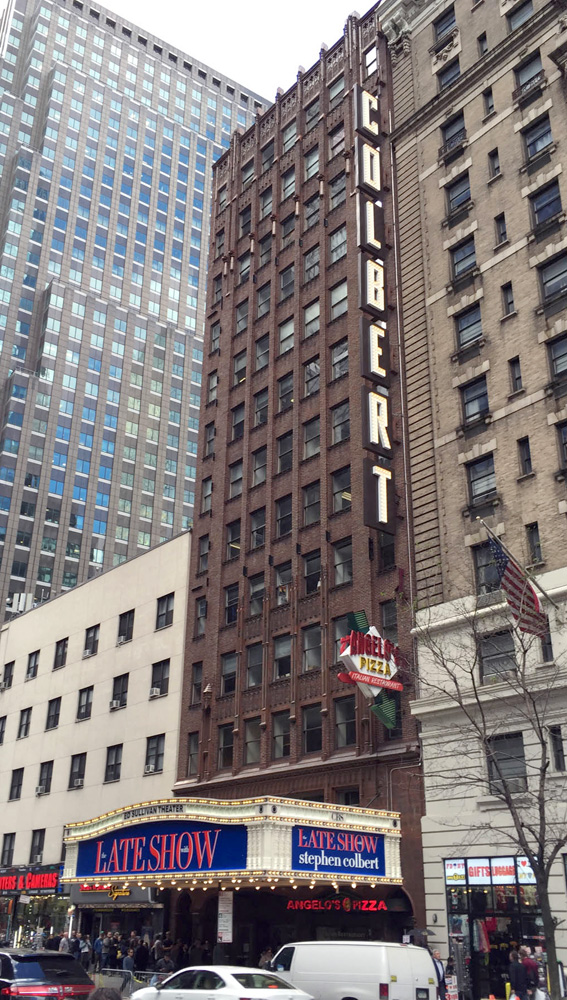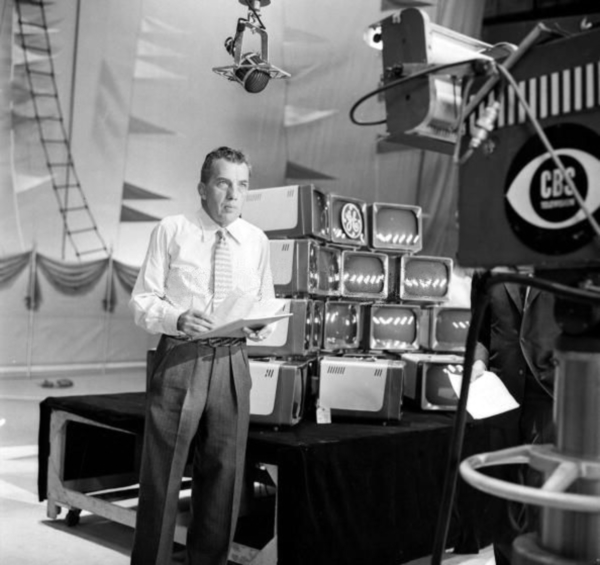
Before all the live shots below were made on a Sunday night in December of 1958, there was a rehearsal. Here, from earlier in the day, is Ed checking the script of his live GE spot against the script on a paper roll teleprompter mounted on a TK30.
Photo courtesy Life Magazine.
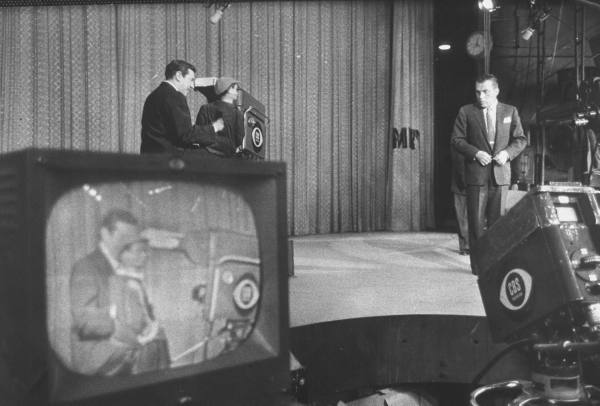
Above is ventriloquist Rickey Layne live on The Ed Sullivan Show. Interestingly, one of CBS’s new TK 11/31s is being used as a prop. Too bad it has a homemade cardboard “helper” on the viewfinder hood. In my humble opinion, the best viewfinder hood style ever developed came on the TK60s, 42s and 44s; it was nice and deep, but the bottom was open and made it easy to see the viewfinder…but, I digress. Notice a TK30 in the foreground for stage level shots.
Photo courtesy of Life Magazine
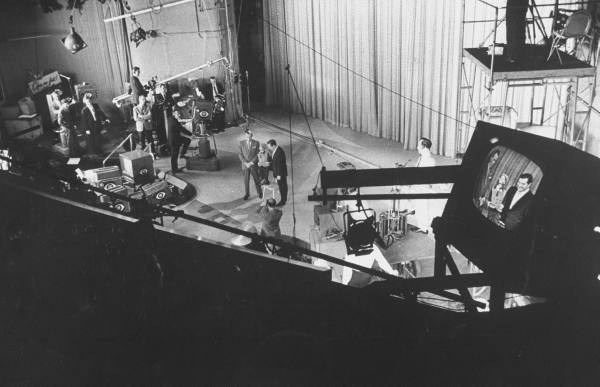
Look closely and you can count six cameras in this picture. The picture just below helps confirm models. There are two TK30s and four TK11/31s on the stage Studio 50. Two TK11/31s are in the upper right, and in the group of three shooting Ed, there’s an 11/31 on the crane, an 11/31 on the camera ramp and a TK30 on the audience floor just below the monitor. There is a TK30 stage right as well, as can be seen below. This facility has had an incredible history and if you want to know all about it, just keep reading this page…it’s all below.
Photo courtesy Life Magazine.
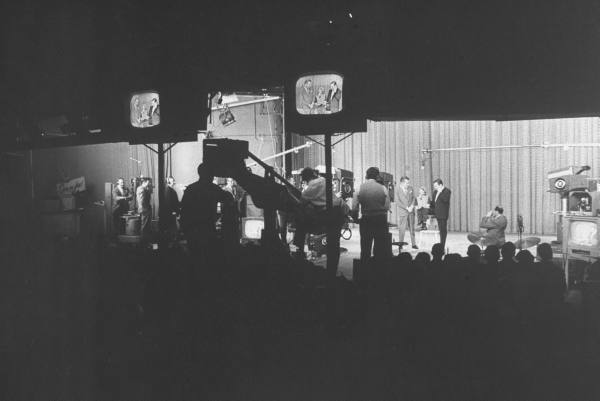
This great shot from the back of the theatre shows a couple of the new TK11/31s together. One is on a Houston Fearless crane and one is on a pedestal, with one of the TK30s in the wings and one on the floor for a stage level shot (just under the crane cameraman’s seat). There are two more TK11/31s on stage left, ready for live spots, as you can see area for commercials on the far left. One of those cameras on stage left is probably only used for shooting title cards.
Photo courtesy of Life Magazine
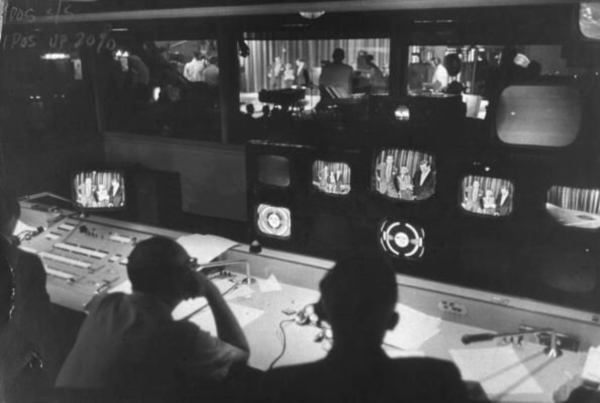
Here is a great shot from the control room.
Photo courtesy of Life Magazine
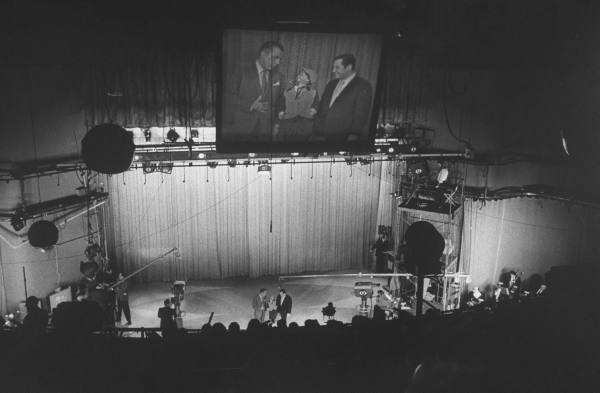
The pictures above and this one from the balcony give us a really great view of how the stage was laid out, and this shows how the balcony audience got to see the show. The round black object in the right foreground is the head of an RCA front screen video projection unit. In the right hand corner, just above the balcony’s rim, you can see a few members of the Ray Bloch Orchestra. On that same side, under the balcony and at the end of the orchestra section, is the audio booth where Art Shine made every singer and band shine for the entire 23-year run of The Ed Sullivan Show. Art also worked the Jackie Gleason program and the Dorsey Brothers’ Stage Show that originated here on Saturday nights.
Photo courtesy Life Magazine.
Below is a history of the show and below that, a history of this still vibrant television landmark. Both are from the official Ed Sullivan web site. It is excellent and brimming with details of every aspect of the show. You can go there by clicking here.
HISTORY OF THE ED SULLIVAN SHOW
The Ed Sullivan Show aired from 1948 until 1971 and changed the landscape of American television. Sullivan’s stage was home to iconic performances by groundbreaking artists from rock ‘n’ roll, comedy, novelty, pop music, politics, sports, opera and more.
There were historic rock ‘n’ roll performances by The Beatles, Elvis Presley, Rolling Stones and The Doors; sensational Motown acts by The Jackson 5, Supremes and Temptations; hilarious stand-up comedy acts by Richard Pryor, Rodney Dangerfield, George Carlin and Carol Burnett; unforgettable Broadway performances by the stars of musicals like My Fair Lady and West Side Story. This list of who stepped on The Ed Sullivan Show stage goes on and on.
You might be wondering – how did The Ed Sullivan Show become the home to the top talent and historical performances of its era?
Often, talk show hosts are charming and competent on camera, yet maybe not the most business-savvy off-screen. Ed Sullivan was just the opposite-pasty in the bright lights, shifty in his stance, and notorious for bungling introductions and monologues.
Ironically, that high discomfort factor helped develop the cult of Ed. There was just something novel about an awkward host, and like a fender bender on the side of the highway, people just couldn’t avert their gaze.
Off camera, Sullivan was a brilliant tracker and arranger of talent. A variety show always has variety, but nothing was as eclectic as the mish-mash that Sullivan put together, from puppet shows to opera, the show had it all.
There were countless acts and performers who made their debuts-or their most famous TV outings-on his show. Ed Sullivan had his finger right on the pulse of what was hot and intriguing in the way of talent, even if he himself didn’t have a discernable pulse onstage. Ed knew how to book ’em better than anyone.
In 1948, CBS hired Sullivan to host its first variety show endeavor, a new format that combined vaudeville with television and was nicknamed “vaudeo.” The show was called The Toast of the Town.
For his inaugural program, Sullivan assembled Dean Martin and Jerry Lewis, Rodgers and Hammerstein, a pianist, a ballerina, a troupe of crooning firemen and a boxing referee whose next gig was the Joe Louis-Jersey Joe Wolcott match. If you wanted to see the phrase “something for everyone” incarnate, there it was.
The critics were rough on Sullivan-they lambasted him for his wooden hosting style and the scattershot tone of his guest menageries. But the show did well anyway.
In 1955, its name changed to The Ed Sullivan Show, and the following year, it broke all of TV’s single night ratings counts when a young Elvis Presley swiveled that famous pelvis on Sullivan’s stage.
June Taylor provided her six dancing “Toastettes,” Ray Bloch led his orchestra, and Sullivan was a Sunday night institution soon enough. Producer Marlo Lewis decided during rehearsals how long each act would last, what order the acts would appear in, and what, out of each performer’s cache of material, should be performed.
A sampling of the people who made their American TV debuts on Sullivan’s show includes: Bob Hope, Lena Horne, Martin and Lewis, Dinah Shore, Albert Schweitzer, Irving Berlin, Fred Astaire and Jane Powell, Eddie Fisher, and most famously, The Beatles.
Most Americans got their first exposure to The Beatles from the historic Ed Sullivan Show broadcast on February 9, 1964. That episode remains one of the most highly watched single shows in TV history. Following which, the “Beatlemania” phenomenon commenced, and the floodgates for other British bands coming to America were opened.
Since hip, cutting-edge musical acts were clearly treating him right, Sullivan responded by booking The Rolling Stones, The Doors, Janis Joplin, Marvin Gaye and Bob Dylan, though Dylan jumped ship when the network wouldn’t let him sing “Talkin’ John Birch Society Blues,” a song about an over-zealous Communist seeker. Not that this was Sullivan’s only problem with emerging rockers: The Stones were banned (temporarily, it turned out) after their rowdy first appearance, and the show’s director asked The Doors to leave out the line “girl we couldn’t get much higher” from “Light My Fire” (they agreed, sang it anyway, and likewise got banned).
Sullivan’s celebrity guests sat in the audience, not backstage in a fancily-catered green room, and sometimes when the acts were introduced, they came right from the audience to the stage. Once in a while, with no prior planning, he’d invite them back up for additional performance.
His interplay with mechanical Italian mouse Topo Gigio, and Senor Wences and his talking box (“S-all right? S-all right!”) showed a soft side on camera, but once again, since the man was a dichotomy, don’t ever think he was all softie.
The Ed Sullivan Show was the quintessential variety show. Whether it was Broadway for the parents, rock ‘n’ roll for the teenagers or Topo Gigio for the kids, the show had something for everyone. From 1948 to 1971, The Ed Sullivan Show was special in that it brought people and families together every Sunday evening. The Ed Sullivan Show was the longest-running variety show in TV history, and an undisputed institution. Towards the end of that long run, with the country divided by Vietnam and shifting value systems, Sullivan’s catchall format didn’t cross the demographic lines like it used to. Time slot rivals The Walt Disney Show and The F.B.I. were gaining momentum, and CBS, eager for youth-oriented programming and fearful that Sullivan was a vestige of older generations, canceled the show.
No matter. Guts and diversity like that, which goes for the show and the man, tend to stick around in a person’s (and a country’s) consciousness.
The Studio 50/Ed Sullivan Theatre history and Time Line
The Ed Sullivan Theater is located at 1697-1699 Broadway between West 53rd and West 54th, in Manhattan, New York. The theater is a 13-story brick building that was designed by architect Herbert Krapp and built by Arthur Hammerstein. Arthur Hammerstein named the theater in honor of his father, Oscar Hammerstein.
Hammerstein’s Theater opened its doors on November 30, 1927 with a three-hour musical play called “The Golden Dawn.” One of the stars of the show that evening was Archie Leach, who later became better known as the famous actor Cary Grant.
In 1931, Arthur Hammerstein, who was facing financial troubles, lost ownership of the building. Over the next five years the theater underwent numerous name changes until in 1935, when CBS secured a long-term contract on the building and began using the theater for radio broadcasts. In 1950, with the growing popularity of a new medium, CBS converted the theater into a television studio named CBS-TV Studio 50.
Ed Sullivan, who had been hosting his variety show “Toast of the Town” out of CBS’s Maxine Elliott Theater (also known as CBS Studio 51), moved into Studio 50 in 1953. The studio went on to become the home of The Ed Sullivan Show for the rest of the variety show’s 23-year run.
On December 10, 1967, to mark The Ed Sullivan Show‘s 20th year, the studio was named The Ed Sullivan Theater in honor of the great host. Like its namesake, The Ed Sullivan Theater has withstood the test of time and to this day remains the studio’s name.
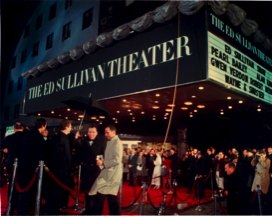
A Timeline of The Ed Sullivan Theater
- 1925-1927 – Arthur Hammerstein builds Hammerstein’s Theater in honor of his father, Oscar Hammerstein I.
- November 30, 1927 – Hammerstein’s Theater opens its doors with a three-hour musical play called The Golden Dawn featuring Archie Leach, who later became known as Cary Grant.
- 1931 – Hammerstein’s Theater is renamed Manhattan Theater.
- 1934 – Manhattan Theater is renamed Billy Rose’s Music Hall and becomes a nightclub.
- 1936 – Billy Rose’s Music Hall is renamed the WPA Theater.
- 1936 – CBS takes over the theater and converts it to a radio theater using various names, including Radio Theater #3 and CBS Radio Playhouse.
- 1950 – With the advent of television, the theater is converted to a television studio named Studio 50.
- 1953 – Studio 50 becomes the home of The Ed Sullivan Show.
- 1960s – Studio 50 also becomes the home of The Honeymooners, The Merv Griffin Show, To Tell The Truth, What’s My Line and Password.
- 1965 – The studio is converted to a color studio for the beginning of the television season.
- December 10, 1967 – Studio 50 receives its latest name, The Ed Sullivan Theater, to honor its host’s twentieth year. Some people say it was the proudest moment of Ed’s life.
- 1970s – The $10,000 Pyramid and a few other game shows call The Ed Sullivan Theater home.
- 1981 – CBS’s lease expires and the theater is taken over by Reeves Entertainment.
- 1980s – The sitcom Kate and Allie is taped in the theater from 1984 to 1989.
- 1993 – David Letterman leaves NBC to join CBS. CBS buys the theater for $4 million and redesigns the space to hold a 400-seat audience.
- July 15, 2009 – Sir Paul McCartney returns to play on the roof of The Ed Sullivan Theater more than 45 years after The Beatles’ Ed Sullivan Show performance on February 9th, 1964.
- 2015 – David Letterman retires after hosting The Late Show for nearly 22 years. CBS has the theater renovated again during the summer months to prepare it for Stephen Colbert’s tenure as host, which begins that fall.
